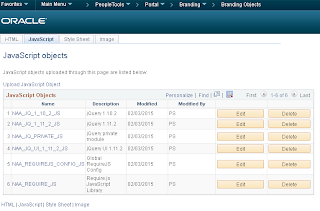Java, JavaScript, C++, C Sharp, Objective C, Groovy... what do these languages have in common? Yes, curly braces, but besides that... actually, there are a lot of similarities between these languages. Throw Visual Basic, Perl, Python, or any other well-known language into the mix and the number of similarities drops significantly. Setting semantics and syntax aside, a common attribute of all well-known languages is standards and best practices. Some of those best practices (such as coding style) differ by language. For example, bash scripts can either look like, uh... bash scripts or they can look like c-style logic statements. Obviously, bash best practices prefer you make bash code look like bash code. Other standards are personal: do you prefer real tabs or spaces? How many spaces does your tab consume? Do you put curly braces on a new line?
How does all of this fit into PeopleCode? Forget about code formatting preferences. Application Designer has its own code formatting ideas. But there are other best practices that can help you write better code with fewer defects (fewer defects = better code). By following best practices your code will be easier to read, you will be more productive, and your users will be happier because you deliver better solutions faster.
Even though best practices usually result in code that is more efficient to process, that isn't really the point. Computers can interpret just about anything. Compilers and interpreters are really good at eliminating useless words and resolving seemingly incomprehensible logic. I love Martin Fowler's quote, "Any fool can write code that a computer can understand. Good programmers write code that humans can understand." Best practices are really about writing code that humans can easily comprehend. For example, avoid complex logic (including double negatives, or any negative logic, for that matter), keep your method and function code short, etc. If you write some code, leave it for a night, and then come back the next day and either need to read lots of comments to figure it out or spend a few minutes "remembering" what that code does, then the code is probably too complex. The problem with complex code is that it is easily misinterpreted by humans. Another problem with complex code is we actually ignore it when trying to resolve problems. We know it takes time to digest complex code, so we avoid it, preferring to test simple code first. Why waste time trying to understand complex code if it might be functioning properly?
Today's Quest Newsletter contained a link to 10 Bad Coding Practices That Wreck Software Development Projects. These are language agnostic practices that we can easily apply to PeopleSoft development.
If I were to summarize Coding best practices, I think I would do it like this: two.sentenc.es. Now, arguably, short does not equal comprehensible. There are programmers that err on the terse side because it is clever. This is true, often short code is clever. It is also hard to read. Most of us, however, err the other way. E. F. Schumacher said, "Any fool can make things bigger, more complex, and more violent. It takes a touch of genius — and a lot of courage — to move in the opposite direction." Schumacher died in 1977, so this problem is not new.
Computer programming is about communication. As programmers we have two audiences:
- Computers (which can interpret anything -- even complex stuff)
- Humans (who have a limited attention span, distractions, and a preference for simplicity)
Here is why I think discipline and best practices are critical for good PeopleCode:
We use PeopleCode to create business rules, but PeopleCode is NOT a business rules language. PeopleCode is a Metadata manipulation language. (Note: this is purely my opinion)
Here is why I believe PeopleCode is for metadata, not business rules: PeopleCode only has Metadata objects: records, fields, SQL, components, menus, etc. These are all metadata. These are the low level API's we use to write business logic. Consider the following PeopleCode:
Localrecord&rec =CreateRecord(Record.PSOPRDEFN);
Local field &descr;
&rec.SelectByKey("jimsoprid");
&descr =&rec.GetField(Field.OPRDEFNDESC);
&descr.Value="JimMarion";
&rec.Update();
This code implements business logic, but does so by manipulating metadata objects. PeopleCode metadata objects are building blocks for business logic. If we were to rewrite this using a business logic language, it would probably look something like this:
Local User &u = GetUser("jimsoprid");
&u.descr ="JimMarion";
&u.Update();And this is why discipline and best practices are SO important for PeopleCode developers: We are trying to speak business logic with a metadata vocabulary. We start with a communication deficit. It is like trying to teach advanced weaving using an automobile mechanics vocabulary. The two subjects have different vocabularies. But if you combine the words correctly, you can communicate the same meaning.


